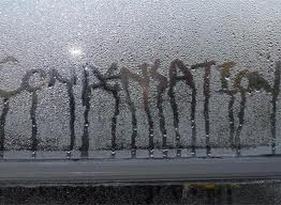
Winter in Florida equals condensation season for many homeowners. Condensation is the accumulation of water on relatively cold surfaces.
Here is your physical science lesson for the day: almost all air contains water vapor, the gas phase of water composed of tiny water droplets. The molecules in warm air are far apart from one another and allow the containment of a relatively large quantity of water vapors. As air cools, its molecules get closer together and squeeze the tiny vapor droplets closer together, as well. A critical temperature, known as the dew point, exists where these water droplets will be forced so close together that they merge into visible liquid in a process called condensation.
The best way to describe this condition is with a soda can analogy. Pull an ice cold soda can out of the cooler in a warm house and let it sit for a while. What happens? The can begins to form little beads of sweat, and that is the same principle behind a sweating window. This type of situation can often be seen by the temperature imbalance between the inside and outside portions of old, inefficient windows, a large majority being aluminum windows.
Sweating windows are a common and prevalent problem in Florida. Many builders believed that insulated, energy-efficient windows were not necessary in this warm climate. In fact, most said it was a waste of money. This line of thinking changed in 2010 when Florida adopted a new building energy code that mandates energy-saving improvement in many areas of a home, especially windows. Aluminum framed windows can still be used when building a home, but energy efficiency must be created in other areas of the home through a complicated energy calculation.
Temporary Condensation
There are several ways to tell if the condensation on your windows is temporary. Does condensation usually form:
Problem Condensation
Excess moisture in your home may eventually cause problems. It may be time to take action if you notice the following signs in your house:
Window Condensation Solutions
1. Reduce Moisture Sources
2. Increase Ventilation
3. Increase Air Temperature
For questions concerning property inspections, or to schedule your property inspection, contact Bennett Property Inspection today at (813) 260-9920.
Here is your physical science lesson for the day: almost all air contains water vapor, the gas phase of water composed of tiny water droplets. The molecules in warm air are far apart from one another and allow the containment of a relatively large quantity of water vapors. As air cools, its molecules get closer together and squeeze the tiny vapor droplets closer together, as well. A critical temperature, known as the dew point, exists where these water droplets will be forced so close together that they merge into visible liquid in a process called condensation.
The best way to describe this condition is with a soda can analogy. Pull an ice cold soda can out of the cooler in a warm house and let it sit for a while. What happens? The can begins to form little beads of sweat, and that is the same principle behind a sweating window. This type of situation can often be seen by the temperature imbalance between the inside and outside portions of old, inefficient windows, a large majority being aluminum windows.
Sweating windows are a common and prevalent problem in Florida. Many builders believed that insulated, energy-efficient windows were not necessary in this warm climate. In fact, most said it was a waste of money. This line of thinking changed in 2010 when Florida adopted a new building energy code that mandates energy-saving improvement in many areas of a home, especially windows. Aluminum framed windows can still be used when building a home, but energy efficiency must be created in other areas of the home through a complicated energy calculation.
Temporary Condensation
There are several ways to tell if the condensation on your windows is temporary. Does condensation usually form:
- during baths and showers, cooking, dish washing, laundry, or other steam producing occasions?
- during the start of each heating season? Houses absorb moisture during humid summers. This will dry out after a few weeks of heating.
- during sharp temperature changes? Sudden drops in temperature, especially during the heating season, can create temporary condensation.
- during new construction or remodeling? Building materials contain a great deal of moisture. When the heat is turned on, this moisture will flow into the air inside the home. It usually will disappear after the first heating season.
Problem Condensation
Excess moisture in your home may eventually cause problems. It may be time to take action if you notice the following signs in your house:
- Condensation remains on windows throughout the day, even when the outside temperature has warmed up.
- Condensation is forming and running down the walls. It may also be causing discoloration, staining, peeling wallpaper and blistering paint.
- The air smells musty – this could indicate mold, mildew, or in the worst cases, rot – or odors from everyday household activities that linger too long. Odors increase in intensity with high relative humidity.
- Mold, mildew, rot and/or decay are visible. Mold and mildew thrive in most areas and can cause health and house damage.
Window Condensation Solutions
1. Reduce Moisture Sources
- Stop or severely limit the use of humidifiers, or adjust them to the appropriate setting.
- Run a dehumidifier if needed.
- Limit plants, aquariums, and pets. If you care for a lot of plants, group them in one sunny room and avoid over watering.
- Have your gas appliances checked, if you have not recently. Malfunctioning gas appliances can deliver excessive water vapor into the air along with more dangerous contaminants. Be sure you have a carbon monoxide alarm.
- Store firewood outside.
- Eliminate plumbing leaks.
- Don’t air-dry clothes indoors.
- Correct grading and drainage problems around exterior of your home.
2. Increase Ventilation
- Open windows for a few minutes each day, particularly after steam-producing activities such as showering/bathing, laundry, and cooking. Heat loss will be minimal.
- Run kitchen, bathroom, and other fans longer and more often.
- Improve or add a ventilation system in your home through attic, roof and soffit venting. Ensure that everything vents to the outside.
- Open blinds and drapes. Heavy window coverings restrict the flow of warm air over the interior glass surface.
- Operate ceiling fans to improve air circulation.
3. Increase Air Temperature
- Raise the temperature inside the house.
- Insulate under the seat and over the head of bay, bow, and garden windows to keep window area warmer.
- Direct warm-air supply ducts toward windows or even use a fan for increased air circulation at windows.
For questions concerning property inspections, or to schedule your property inspection, contact Bennett Property Inspection today at (813) 260-9920.

 RSS Feed
RSS Feed

